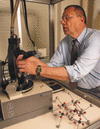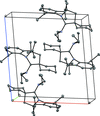issue contents
September 2021 issue

Cover illustration: Teaching space-group symmetry is an important and crucial part of any crystallography course. In this issue, Bruce Foxman describes the development and use of a tutorial containing more than 220 PowerPoint slides as teaching material. The work described here was done in conjunction with Jerry Jasinski, for whom we will be publishing a tribute special issue in conjunction with the Journal of Chemical Crystallography. See: Foxman [Acta Cryst. (2021). E77, 857–863].
modern approaches and tools for teaching crystallography
Knowledge of space groups and the implications of space group symmetry on the physical and chemical properties of solids are pivotal factors in all areas of structural science. The tutorial contains > 200 PowerPoint `slides', in five modules, arranged by crystal class; a sixth module covers special topics. A `credits' module gives the direct addresses of all embedded links. In the tutorial, lattice points build iteratively and interactively with keyclick, and the coordinates of points `pop up' as the unit cell is filled.
`Symmetry and Space Group Tutorial' (by Jerry P. Jasinski and Bruce M. Foxman) provides chemistry students an opportunity to learn space-group diagrams through the peer-tutoring approach.
Jerry P. Jasinski tribute
Download citation


Download citation


Two crystallographically independent molecules are present in the asymmetric unit. O—H⋯O, N—H⋯O and C—H⋯O hydrogen bonds form rings and chains and π–π stacks further connect molecules in the crystal.
CCDC reference: 1540679
Download citation


Download citation


[Rh(μ-I)(COD)]2 was found to crystallize as two different polymorphs in which the Rh dimer adopts either bent or planar geometries with respect to the Rh2I2 core.
Download citation


Download citation


The unsubstituted cyclopentadienyl ring is rotationally disordered while the other Cp ring and its substituent are close to coplanar. In the crystal, the molecules pack in `bilayers' parallel to the ab plane with the ferrocenyl groups on the outer faces and the substituents directed towards the regions between them. The ferrocenyl groups are linked by C—H⋯π(ring) interactions.
CCDC reference: 2101472
Download citation


Download citation


Five new bis(arylamide)dichloridozinc(II) complexes have been prepared and characterized. All of the complexes contain hydrogen bonds between the amide N—H group and the amide carbonyl oxygen atoms or the chlorine atoms, forming extended networks.
research communications
Download citation


Download citation


The title compound was synthesized from a dinitrobiphenylbenzene derivative using a novel modification of the Cadogan reaction. The reaction has several possible ring-closed products and the title compound was separated as the major product. It crystallizes in the monoclinic P![[\overline{1}]](/e/issues/2021/09/00/ex2047/teximages/ex2047fi1.svg) space group and possesses a single closed Cadogan ring.
space group and possesses a single closed Cadogan ring.
CCDC reference: 2099768
Download citation


Download citation


The title compound crystallizes in space group P1 despite being achiral. Two classical hydrogen bonds link the molecules to form a layer structure.
CCDC reference: 2099652
Download citation


Download citation


In the molecule of title compound, intramolecular π–π interactions between the indole unit and benzene ring help to establish the clip-shaped conformation of the molecule. In the crystal, the molecules are assembled into two-dimensional layers via C—H⋯O hydrogen bonds, π–π and C—H⋯π interactions.
CCDC reference: 2100362
Download citation


Download citation


The crystal structure of (C9H7N2)3Bi2I9 contains dinuclear [Bi2I9]3− anions, formed by two face-sharing octahedra, and protonated 1,8-diazabicyclo[5.4.0]undec-7-ene (DBU) cations.
CCDC reference: 2100182
Download citation


Download citation


A diethylamine adduct of a cyclic(alkyl)(amino)carbene was synthesized and characterized by single-crystal X-ray diffraction and NMR spectroscopy.
CCDC reference: 2100575
Download citation


Download citation


Pairs of molecules in the crystal are linked into dimers by N—H⋯O hydrogen bonds, forming an ![[R_{2}^{2}]](/e/issues/2021/09/00/wm5614/teximages/wm5614fi1.svg) (12) ring motif. The dimers are connected through π–π stacking interactions between the centroids of the benzene and furan rings of their 2,3-dihydro-1-benzofuran ring systems. C—H⋯π interactions consolidate the crystal packing.
(12) ring motif. The dimers are connected through π–π stacking interactions between the centroids of the benzene and furan rings of their 2,3-dihydro-1-benzofuran ring systems. C—H⋯π interactions consolidate the crystal packing.
CCDC reference: 1984938
Download citation


Download citation


Crystal structures of phosphine-supported (η5-cyclopentadienyl)molybdenum(II) propionyl complexes
Solid-state structures are presented for three propionyl complexes of MoII featuring piano-stool geometries and supported by triarylphosphine ligands, showing the effects of para substitution on supramolecular structure and allowing comparison to the large class of previously reported acetyl complexes.
Download citation


Download citation


The title compounds, C23H25Br2NO2 (1) and C31H29BrN2O4 (2), crystallize in the space group P21/n with two and one molecules, respectively, in the asymmetric unit of the cell. The molecular conformation of these compounds is stabilized by intramolecular C—H⋯O hydrogen bonds and C—H⋯N or C—H⋯π interactions. The crystal structure of 1 features a relatively strong Br⋯O=C halogen bond, which is not observed in the case of 2. Both crystal structures are characterized by the presence of C—H⋯Br hydrogen bonds and numerous intermolecular C—H⋯O hydrogen-bonding interactions.
Download citation


Download citation


The crystal structure of LiNa3(SO4)2·6H2O is discussed. In the context of the production of LiOH for batteries, the formation of the double salt should be avoided. Detection of its presence by means of XRD is important.
Download citation


Download citation


The molecular conformation of the title compound is stabilized by an intramolecular O—H⋯O hydrogen bond, forming an S(6) ring motif. Intermolecular N—H⋯N and C—H⋯N hydrogen bonds, as well as N—H⋯π and C—H⋯π interactions create a three-dimensional network in the crystal.
CCDC reference: 2101203
Download citation


Download citation


In the heterobimetallic cadmium–sodium complex, heptaaqua-1κ3O,2κ2O,3κ2O-bis(μ-4,6-dioxo-1,4,5,6-tetrahydro-1,3,5-triazin-2-olato)-1:2κ2O2:N1;2:3κ2N1:O2-bis(4,6-dioxo-1,4,5,6-tetrahydro-1,3,5-triazin-2-olato)-1κO2,3κO2-2-cadmium-1,3-disodium, the ligand coordination around the Cd and Na atoms leads to the formation of a two-dimensional coordination polymer in the (110) plane, which is supported by means of a variety of N—H⋯O, O—H⋯O and O—H⋯N intermolecular and intramolecular interactions owing to different substitution patterns.
CCDC reference: 1576691
Download citation


Download citation


The title compound, {[Co2(C12H7NO8)(H2O)2]·1.6H2O}n, features tetranuclear CoII units bridged by κ3O:O:O′- and κ3O:O,O′-carboxylate groups from deprotonated 2-aminodiacetic terephthalic acid, which are joined into CoII ribbons via syn–anti carboxylate bridges. The parallel-aligned adtp4− ligands with an alternately reversed arrangement further link adjacent CoII ribbons into (010) layers, which are assembled into a three-dimensional supramolecular architecture via intermolecular hydrogen bonds.
CCDC reference: 2063394
Download citation


Download citation


The title compound consists of parallel stacked chains of composition {[Co2(C12H7NO8)(H2O)6]}n in which CoII cations are linked together through 2-aminodiacetic terephthalate anions. The chains are held together by networks of hydrogen bonds involving both coordinated and free water molecules in water tapes and pentamers.
CCDC reference: 2063370
Download citation


Download citation


The molecular and crystal structure of the [Co(H2O)2(phen)2]2[Ge(HCit)2](NO3)2 (H4Cit is citric acid, phen is 1,10-phenanthroline) compound was studied using X-ray diffraction analysis.
CCDC reference: 2103184
Download citation


Download citation


The crystal structure of 4-chloro-1H-pyrazole has been determined at 170 K, showing a hydrogen-bonded trimeric molecular assembly that is isostructural to its bromo analogue, 4-bromo-1H-pyrazole.
CCDC reference: 2103822
Download citation


Download citation


The crystal structures of three N-(pyridine-2-carbonyl)pyridine-2-carboxamide ligands, with or without F atoms on the 3-position of the pyridine ring, with potential use in supramolecular chemistry are reported.
Download citation


Download citation


Two similar molecules make up the asymmetric unit of the title compound. The crystal structure features short C—H⋯Cl and C—H⋯O contacts and C—H⋯π and van der Waals interactions.
CCDC reference: 1984582


 journal menu
journal menu









































